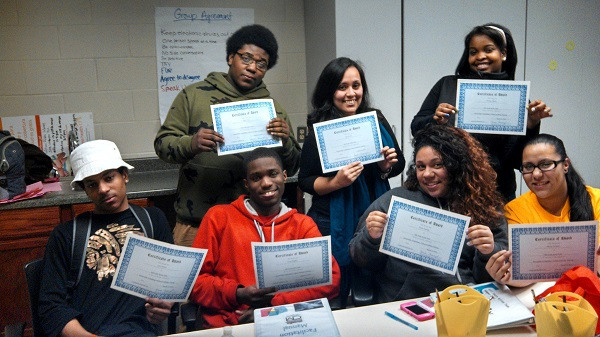Resolving conflict through mutual respect
For more than three decades, Community Mediation has helped people peacefully resolve their conflicts.
 |
| Youth graduates of a Community Mediation facilitation workshop. Photo credit: Community Mediation. |
A teenage boy is arrested for assaulting an older man who lives next door. Because it is a first-time offense, his case is referred to the New Haven Juvenile Review Board, an alternative to the criminal court system. There it is learned that not only was the boy provoked, but that the two families have had a long-running feud. The board staff decides to call in both families for a mediation session.
Once the two families are face to face across a table, no one can remember how their fighting started or why they hated each other. The ice is broken, and after several hours of talking and listening to each other, the man and the boy hug. The families depart having made plans to barbecue with each other.
"If that case had gone to court, you would have had resentment from the boy's family and the conflict would have escalated," says Community Mediation Inc. Executive Director Brenda Cavanaugh. "People will say that with mediation, we're letting people off easy. But what is our ultimate goal? Is it to have a peaceful community? Or is to have revenge and punishment?"
The roots of community mediation go back to the early 1970s, when the counter-culture movement sought to shift conflict resolution from the court system to the community. Mediation sessions are guided by a trained facilitator who helps the conflicting parties listen to each other with mutual respect and collaborate to reach a resolution.
"We're focused on allowing the parties to come up with their own solutions. When you give people the time to vent and be listened to, the solutions to problems start to emerge."
While there are now 250 community mediation centers across the country, Community Mediation Inc. is the only stand-alone center in Connecticut. It started in 1980 as a neighborhood walk-in center in Fair Haven. Now located in Hamden, the organization has grown to provide a range of services to individuals and institutions. It offers conflict resolution sessions to workplaces, schools, neighbors, families, couples and faith organizations. It also trains teachers, case workers for at-risk youth and community members.
Community Mediation is supported with a diversity of funding sources including a sliding-scale fee for services, the state, individual donors and foundations including The Community Foundation for Greater New Haven.
When a conflict has a victim and an aggressor, the mediation process can be healing to both parties. In a case at Hamden Middle School, a group of students were brought into a mediation session after they were caught smearing ink on the seat of a school bus. Sitting with the woman who drove their school bus, the kids admitted that they never realized that she was the one who had to clean it up.
"At the end they apologized profusely," Cavanaugh says. "And the driver was so thankful that for the first time in 20 years, she got to tell kids how they affected her. If you do it right and take the time it creates a transformative culture. It creates a culture of connection and one where kids feel they have responsibility for each other."
To learn more about Community Mediation Inc. and support its mission, visit its profile on giveGreater.org®.
Did you know?
Until 2010, Community Mediation worked under a contract with the state courts and was referred about 900 cases per year, according to Cavanaugh. The program was a victim of budget cuts.
This story is part of the Inspiration Monday story series produced by The Community Foundation for Greater New Haven.
